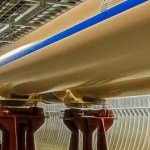quark-gluon plasma
Theoretical physicist Raju Venugopalan
We sat down with Brookhaven theoretical physicist Raju Venugopalan for a conversation about “color glass condensate” and the structure of visible matter in the universe.
Q. We've heard a lot recently about a "new form of matter" possibly seen at the Large Hadron Collider (LHC) in Europe — a state of saturated gluons called “color glass condensate.” Brookhaven Lab, and you in particular, have a long history with this idea. Can you tell me a bit about that history?
A. The idea for the color glass condensate arose to help us understand heavy ion…
RHIC, the Relativistic Heavy Ion Collider at Brookhaven Lab, found it first: a “perfect” liquid of strongly interacting quarks and gluons – a quark-gluon plasma (QGP) – produced by slamming heavy ions together at close to the speed of light. The fact that the QGP produced in these particle smashups was a liquid and not the expected gas, and that it flowed like a nearly frictionless fluid, took the physics world by surprise. These findings, now confirmed by heavy-ion experiments at the Large Hadron Collider (LHC) in Europe, have raised compelling new questions about the nature of matter and…
This guest post is written by BNL theoretical physicist Raju Venugopalan. After earning his Ph.D. from Stony Brook University in 1992, Venugopalan worked at several universities in the United States and at the Niels Bohr Institute in Copenhagen, Denmark, before joining Brookhaven in 1998. He is the leader of the nuclear theory group in Brookhaven's physics department.
Raju Venogopalan
Last week, members of the Compact Muon Solenoid (CMS) collaboration at CERN's Large Hadron Collider (LHC) announced that they've found a phenomenon that's similar to one observed by physicists at Brookhaven…
This is the first in an occassional series about Brookhaven's Relativistic Heavy Ion Collider, or, as it's affectionately called, RHIC.
Lil John has a theme song for RHIC's latest experimental run.
Sorry, sorry! I couldn't resist. RHIC's actual ditty of the moment goes more like this. (Clean version, of course, RHIC doesn't want any soap in its linac).
RHIC, which has a maximum potential energy of 200 billion electron volts (GeV), collided gold ions at energies as low as 7.7 GeV this spring -- the lowest ever achieved in the machine. But why go so low?
Even at low energies, the gold-gold…

